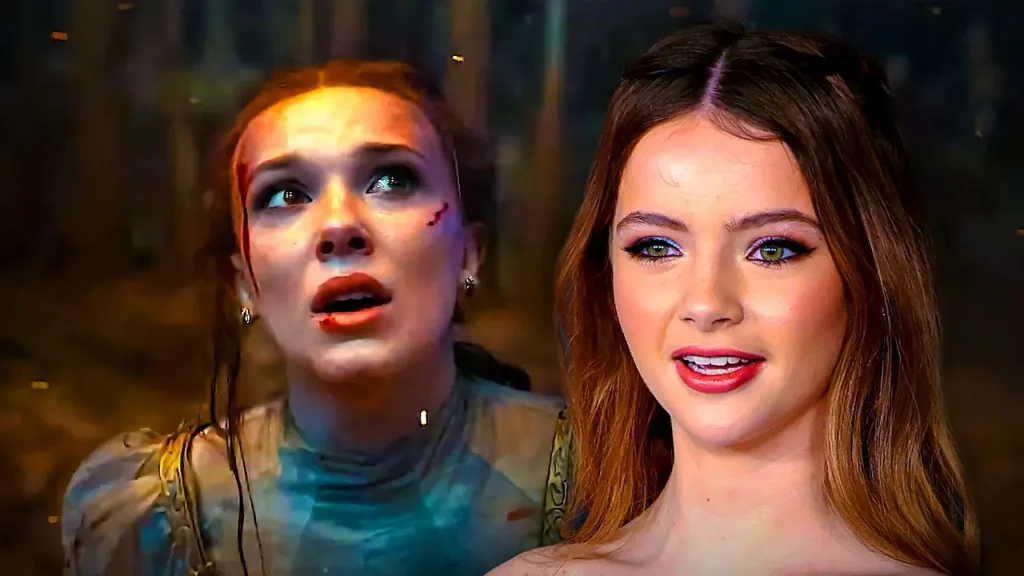In Netflix’s medieval fantasy film “Damsel,” Elodie, portrayed by Millie Bobby Brown, transitions from a princess in peril to a formidable warrior. Directed by Juan Carlos Fresnadillo, the movie transports viewers to a world filled with dragons and other fantastical creatures. Elodie, the daughter of Lord Bayford (Ray Winstone), finds herself at the center of a dire situation as her family’s land faces poverty and famine. To alleviate their plight, Lord Bayford strikes a deal with Queen Isabelle of Aurea (Robin Wright).
The agreement entails Elodie marrying Queen Isabelle’s son, Prince Henry (Nick Robinson), in exchange for a substantial sum of gold that Lord Bayford intends to use to aid his people. However, the arrangement takes a dark turn when it is revealed that Elodie is also meant to be sacrificed to a dragon—a grim aspect of a longstanding agreement between the royals of Aurea and the dragon. Thus begins Elodie’s struggle for survival and her quest to reunite with her family.
While the movie concludes with Elodie achieving a satisfying and happy resolution, an alternate ending was considered—one that would have been more aligned with her character’s original aspirations.
Brooke Carter, who plays Elodie’s younger sister Floria, disclosed that an alternate ending was filmed for “Damsel.” Speaking to The Direct, Carter revealed that this alternate ending saw Elodie departing from her homeland, setting the stage for a different trajectory for her character. Carter expressed enthusiasm about the potential of this alternate ending, suggesting that its release could spark speculation and excitement about Elodie’s future adventures and the broader world of “Damsel.”
In the alternate ending, after the dragon exacts vengeance by incinerating the palace and its inhabitants, Elodie chooses to leave with Floria and their stepmother, Lady Bayford (Angela Bassett).
In the final version of “Damsel,” Elodie and Floria emerge from the cave after Elodie reveals the truth about the dragon’s history. Their newfound understanding strengthens the bond between Elodie and the dragon, leading them to unite against Queen Isabelle and her kingdom. Subsequently, after the dragon’s fiery retribution upon the palace and its occupants, Elodie, Floria, and Lady Bayford depart, embarking on a journey homeward laden with provisions and accompanied by the dragon.
While the film’s ending provides closure for Elodie’s narrative arc, it diverges from her initial desires. When confronted with the prospect of marriage, Elodie expressed a desire to explore the world rather than settle down. Thus, the alternate ending, which sees her embracing her wanderlust and departing on a journey of discovery, would have been more thematically consistent with her character.
Furthermore, the alternate ending would have paved the way for potential sequels and expanded the cinematic universe of “Damsel.” By allowing Elodie to pursue her dreams of exploration, it would have opened up avenues for further storytelling and character development. While the likelihood of the alternate ending’s release remains uncertain, its adoption would have offered a more fitting conclusion for Elodie and enriched the movie’s narrative possibilities.
FAQ
What is the alternate ending of “Damsel”?
In the alternate ending of “Damsel,” Elodie chooses to leave her homeland with her sister Floria and stepmother Lady Bayford after the dragon exacts vengeance upon the palace and its inhabitants. This departure contrasts with the final version of the film, where Elodie remains in her homeland after the dragon’s retaliation.
Why was an alternate ending considered for “Damsel”?
Alternate endings are not uncommon in filmmaking, offering directors and writers the opportunity to explore different narrative trajectories and character developments. In the case of “Damsel,” an alternate ending was considered to provide a different conclusion for Elodie’s character and potentially set the stage for future sequels or expanded storytelling within the film’s universe.
What would have been different in the alternate ending of “Damsel”?
In the alternate ending, Elodie’s decision to leave her homeland aligns more closely with her initial desires for exploration and adventure, as opposed to the resolution presented in the final cut of the film. This departure would have allowed Elodie to pursue her dreams and embark on a journey of self-discovery, potentially leading to new narrative avenues and character arcs.
Will the alternate ending of “Damsel” be released?
While there is no confirmation of the alternate ending being released, speculation persists about its potential unveiling and the discussions it could spark regarding Elodie’s future adventures and the broader world of “Damsel.” The decision to release alternate endings often rests with filmmakers and production studios.
How does the alternate ending of “Damsel” impact the overall narrative?
The alternate ending offers a different resolution for Elodie’s character, one that emphasizes her desire for independence and exploration. By departing from her homeland, Elodie’s journey opens up possibilities for further storytelling, potential sequels, and expanded world-building within the universe of “Damsel.”
